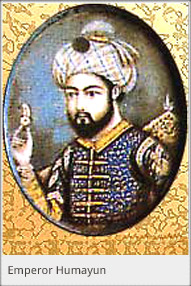Babur was succeeded by his eldest son Humayun. Humayun failed in asserting a strong monarchical authority. He inherited a freshly won empire with a host of troubles; the Afghan nobles, the Rajputs and worst of all, his three treacherous brothers. They caused numerous problems for him. Following his father’s advice, Humayun treated his brothers kindly and appointed them to high positions. Kamran was appointed as the Governor of Kabul, Kandhar and later even Punjab. Askari was the Governor of Sambhal, and Hindal the Governor of Alwar. In return, his brothers hindered him at every step and betrayed him in his hour of need. All of them coveted the throne. This was a curse that each successful Mughal king had to deal with. Humayun almost lost the empire his father had fought so hard to bequeath him. In the first ten years of his rule, he faced so many challenges not only from his younger brothers but also from the Afghan General Sher Shah Suri who had served under Babur. Sher Shah Suri defeated Humayun in the battles of Chausa and Kanauj in 1540. This defeat was the first setback to the infant Mughal Empire. He lived the next 15 years of his life, from 1540 to 1555, self-exiled in Persia. Later on, with the help of the King of Persia, he captured Kabul and Kandhar. He was finally able to re-ascend the throne at Delhi and Agra after defeating Sikandar Suri. After recovering his throne, Humayun devoted himself to the affairs of the kingdom and towards improving the system of government. He laid the foundation of the Mughal style of painting. Later on, during the reign of Akbar, a fusion of Persian and Indian style of painting took place.
 Unfortunately, after recovering his empire, Humayun was not destined to rule for long. In January 1556, he met his tragic end by slipping from the famous building known as Din Panah. After him his eldest son Akbar took over the rule of the empire.
Unfortunately, after recovering his empire, Humayun was not destined to rule for long. In January 1556, he met his tragic end by slipping from the famous building known as Din Panah. After him his eldest son Akbar took over the rule of the empire.
This article was last updated on Sunday, June 01, 2003






